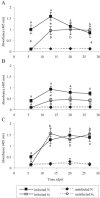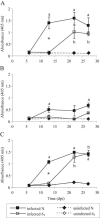A strong antigen-specific T-cell response is associated with age and genetically dependent resistance to avian enteric salmonellosis
- PMID: 16239553
- PMCID: PMC1273861
- DOI: 10.1128/IAI.73.11.7509-7516.2005
A strong antigen-specific T-cell response is associated with age and genetically dependent resistance to avian enteric salmonellosis
Abstract
Chicken genetics and age affect resistance to enteric infection with Salmonella enterica serovar Typhimurium and were used to identify the immune responses that may contribute to rapid clearance. When birds were infected at 40 days of age, line 6(1) chickens cleared the infection more effectively than line N chickens, whereas when birds were infected at 10 days of age, both chicken lines were highly susceptible to infection. Antibody levels, T-cell responsiveness, and cytokine mRNA levels were all elevated during infection. A negative correlation between resistance and antigen-specific antibody production was observed in older chickens. However, this finding was not replicated for age-related resistance; we found that older chickens exhibited a stronger and more rapid antibody response than younger chickens. The levels of interleukin-1beta (IL-1beta) and gamma interferon (IFN-gamma) mRNA were similar in the spleens and cecal tonsils of both line 6(1) and line N chickens, except for higher levels of IL-1beta in the spleens of line 6(1) chickens at 6 days postinfection. Differences in the levels of IFN-gamma and IL-1beta 1beta mRNA between the lines were more apparent in younger chickens, but while the increases were greater than those observed in the older chickens, the clearance of enteric S. enterica serovar Typhimurium was much slower. The level of antigen-specific proliferation of splenocytes was associated with increased resistance in both experimental systems, and the strongest responses were observed in older and genetically resistant chickens. The data presented here implicate T-cell responses in the clearance of S. enterica serovar Typhimurium from the intestine of infected chickens.
Figures






References
-
- Arnold, J. W., and P. S. Holt. 1995. Response to Salmonella Enteritidis infection by the immunocompromised avian host. Poult. Sci. 74:656-665. - PubMed
-
- Babu, U., R. A. Dalloul, M. Okamura, H. S. Lillehoj, H. Xie, R. B. Raybourne, D. Gaines, and R. A. Heckert. 2004. Salmonella enteritidis clearance and immune responses in chickens following Salmonella vaccination and challenge. Vet. Immunol. Immunopathol. 101:251-257. - PubMed
-
- Babu, U., M. Scott, M. J. Myers, M. Okamura, D. Gaines, H. F. Yancy, H. Lillehoj, R. A. Heckert, and R. B. Raybourne. 2003. Effects of live attenuated and killed Salmonella vaccine on T-lymphocyte mediated immunity in laying hens. Vet. Immunol. Immunopathol. 91:39-44. - PubMed
Publication types
MeSH terms
Substances
LinkOut - more resources
Full Text Sources
Medical

